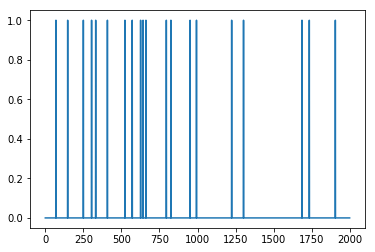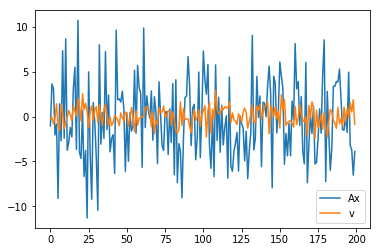故障检测
我们将考虑一个基于系统性能传感器测量的问题,即确定系统中已发生的故障。
主题参考
问题陈述
每个可能的故障以概率 \(p\) 独立发生。向量 \(x \in \lbrace 0,1 \rbrace^{n}\) 编码了故障的发生情况,其中 \(x_i = 1\) 表示故障 \(i\) 已发生。系统性能由 \(m\) 个传感器测量。传感器输出为
其中 \(A \in \mathbf{R}^{m \times n}\) 是感知矩阵,其中列 \(a_i\) 是故障 \(i\) 的**故障标识**,而 \(v \in \mathbf{R}^m\) 是一个噪声向量,其中 \(v_j\) 是均值为0、方差为 \(\sigma^2\) 的高斯分布。
目标是根据 \(y`(传感器测量值)猜测 :math:`x`(发生了哪些故障)。我们感兴趣的是 :math:`n > m\) 的情况,也就是说,当我们有更多的潜在错误比测量时。在这种情况下,我们可以期望在向量 \(x\) 稀疏时获得很好的恢复结果。这就是压缩感知的主题。
解决方法
为了识别错误,一种合理的方法是选择 \(x \in \lbrace 0,1 \rbrace^{n}\) 来最小化负对数似然函数
然而,由于 \(x\) 必须是布尔型的约束条件,这个问题是非凸的且 NP-难的。
为了使这个问题可行,我们可以放宽布尔约束条件,而是约束 \(x_i \in [0,1]\)。
优化问题
通过对 \(x\) 的放松的 ML 估计进行四舍五入,将其近似到 0 或 1,我们可以得到一个布尔估计的故障发生情况。
示例
我们将生成一个带有 \(n = 2000\) 个可能故障,\(m = 200\) 个测量和故障概率 \(p = 0.01\) 的示例。我们选择 \(\sigma^2\) 来使得信噪比为 5。也就是说,
import numpy as np
import matplotlib.pyplot as plt
np.random.seed(1)
n = 2000
m = 200
p = 0.01
snr = 5
sigma = np.sqrt(p*n/(snr**2))
A = np.random.randn(m,n)
x_true = (np.random.rand(n) <= p).astype(int)
v = sigma*np.random.randn(m)
y = A.dot(x_true) + v
下面,我们展示 \(x\),\(Ax\) 和噪声 \(v\)。
plt.plot(range(n),x_true)
[<matplotlib.lines.Line2D at 0x11ae42518>]

plt.plot(range(m), A.dot(x_true),range(m),v)
plt.legend(('Ax','v'))
<matplotlib.legend.Legend at 0x11aee9630>

恢复
我们使用CVXPY解决放松的最大似然问题,然后将结果舍入得到布尔解。
##时间
import cvxpy as cp
x = cp.Variable(shape=n)
tau = 2*cp.log(1/p - 1)*sigma**2
obj = cp.Minimize(cp.sum_squares(A*x - y) + tau*cp.sum(x))
const = [0 <= x, x <= 1]
cp.Problem(obj,const).solve(verbose=True)
print("final objective value: {}".format(obj.value))
#放宽的最大似然估计
x_rml = np.array(x.value).flatten()
#舍入解
x_rnd = (x_rml >= .5).astype(int)
ECOS 2.0.4 - (C) embotech GmbH, Zurich Switzerland, 2012-15. Web: www.embotech.com/ECOS
It pcost dcost gap pres dres k/t mu step sigma IR | BT
0 +7.343e+03 -3.862e+03 +5e+04 5e-01 5e-04 1e+00 1e+01 --- --- 1 1 - | - -
1 +4.814e+02 -9.580e+02 +8e+03 1e-01 6e-05 2e-01 2e+00 0.8500 1e-02 1 2 2 | 0 0
2 -2.079e+02 -1.428e+03 +6e+03 1e-01 4e-05 8e-01 2e+00 0.7544 7e-01 2 2 2 | 0 0
3 -1.321e+02 -1.030e+03 +5e+03 8e-02 3e-05 7e-01 1e+00 0.3122 2e-01 2 2 2 | 0 0
4 -2.074e+02 -8.580e+02 +4e+03 6e-02 2e-05 6e-01 9e-01 0.7839 7e-01 2 2 2 | 0 0
5 -1.121e+02 -6.072e+02 +3e+03 5e-02 1e-05 5e-01 7e-01 0.3859 4e-01 2 3 3 | 0 0
6 -4.898e+01 -4.060e+02 +2e+03 3e-02 8e-06 3e-01 5e-01 0.5780 5e-01 2 2 2 | 0 0
7 +7.778e+01 -5.711e+01 +8e+02 1e-02 3e-06 1e-01 2e-01 0.9890 4e-01 2 3 2 | 0 0
8 +1.307e+02 +6.143e+01 +4e+02 6e-03 1e-06 6e-02 1e-01 0.5528 1e-01 3 3 3 | 0 0
9 +1.607e+02 +1.286e+02 +2e+02 3e-03 4e-07 3e-02 5e-02 0.8303 3e-01 3 3 3 | 0 0
10 +1.741e+02 +1.557e+02 +1e+02 2e-03 2e-07 2e-02 3e-02 0.6242 3e-01 3 3 3 | 0 0
11 +1.834e+02 +1.749e+02 +5e+01 8e-04 9e-08 8e-03 1e-02 0.8043 3e-01 3 3 3 | 0 0
12 +1.888e+02 +1.861e+02 +2e+01 3e-04 3e-08 2e-03 4e-03 0.9175 3e-01 3 3 2 | 0 0
13 +1.909e+02 +1.902e+02 +4e+00 7e-05 7e-09 6e-04 1e-03 0.8198 1e-01 3 3 3 | 0 0
14 +1.914e+02 +1.912e+02 +1e+00 2e-05 2e-09 2e-04 3e-04 0.8581 2e-01 3 2 3 | 0 0
15 +1.916e+02 +1.916e+02 +1e-01 2e-06 3e-10 2e-05 4e-05 0.9004 3e-02 3 3 3 | 0 0
16 +1.916e+02 +1.916e+02 +4e-02 7e-07 8e-11 7e-06 1e-05 0.8174 1e-01 3 3 3 | 0 0
17 +1.916e+02 +1.916e+02 +8e-03 1e-07 1e-11 1e-06 2e-06 0.8917 9e-02 3 2 2 | 0 0
18 +1.916e+02 +1.916e+02 +2e-03 4e-08 4e-12 4e-07 5e-07 0.8588 2e-01 3 3 3 | 0 0
19 +1.916e+02 +1.916e+02 +2e-04 3e-09 3e-13 3e-08 5e-08 0.9309 2e-02 3 2 2 | 0 0
20 +1.916e+02 +1.916e+02 +2e-05 4e-10 4e-14 4e-09 6e-09 0.8768 1e-02 4 2 2 | 0 0
21 +1.916e+02 +1.916e+02 +4e-06 6e-11 6e-15 6e-10 9e-10 0.9089 6e-02 4 2 2 | 0 0
22 +1.916e+02 +1.916e+02 +1e-06 2e-11 2e-15 2e-10 2e-10 0.8362 1e-01 2 1 1 | 0 0
OPTIMAL (within feastol=1.8e-11, reltol=5.1e-09, abstol=9.8e-07).
Runtime: 6.538894 seconds.
final objective value: 191.6347201927456
CPU times: user 6.51 s, sys: 291 ms, total: 6.8 s
Wall time: 7.5 s
Evaluation
我们定义了一个计算估计误差的函数和一个用于绘制数学公式“x”、松弛最大似然估计和四舍五入解的函数。
import matplotlib
def errors(x_true, x, threshold=.5):
'''返回估计误差。
返回真实的故障数量、误报数量和漏报数量。
'''
n = len(x_true)
k = sum(x_true)
false_pos = sum(np.logical_and(x_true < threshold, x >= threshold))
false_neg = sum(np.logical_and(x_true >= threshold, x < threshold))
return (k, false_pos, false_neg)
def plotXs(x_true, x_rml, x_rnd, filename=None):
'''绘制真实、松弛最大似然估计和四舍五入解。'''
matplotlib.rcParams.update({'font.size': 14})
xs = [x_true, x_rml, x_rnd]
titles = ['x_true', 'x_rml', 'x_rnd']
n = len(x_true)
k = sum(x_true)
fig, ax = plt.subplots(1, 3, sharex=True, sharey=True, figsize=(12, 3))
for i,x in enumerate(xs):
ax[i].plot(range(n), x)
ax[i].set_title(titles[i])
ax[i].set_ylim([0,1])
if filename:
fig.savefig(filename, bbox_inches='tight')
return errors(x_true, x_rml,.5)
我们可以看到,在20个实际故障中,四舍五入解完美恢复,没有漏报和误报。
plotXs(x_true, x_rml, x_rnd, 'fault.pdf')
(20, 0, 0)
